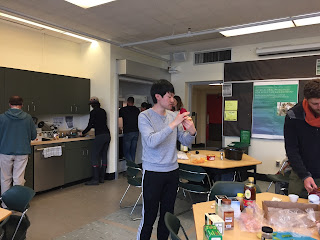We had a great workshop yesterday, despite the onset of rain!
Tiddley Cove Morris Dancers & Musicians taught traditional dances and songs centred around the agricultural year -- Speed the Plough, Lively Jig, Country Life and Hal and Tow. Everyone got the chance to try a dance and some songs, and to think about incorporating arts-based approaches and seasonal, agri/cultural traditions in garden-based learning.
Wendy Traas from the UBC Education Library launched the new UBC Seed Library with us. She introduced us to the concept of seed-sharing and seed-saving through the Library, and as a bonus, gave us all packets of lovely seeds to take home and plant!
 Everyone brought an evocative ingredient to the Cook-Telling workshop. We told our food stories about the ingredients we brought, and then combined them with staple ingredients like lentils, pasta, chick peas and one onion that we shared to improvise some very delicious and healthy vegetarian lunch dishes, with some unlikely but yummy combinations. (French Camembert cheese, Korean red pepper paste, Indian spices and Italian olives, anyone? It turned out great!)
Everyone brought an evocative ingredient to the Cook-Telling workshop. We told our food stories about the ingredients we brought, and then combined them with staple ingredients like lentils, pasta, chick peas and one onion that we shared to improvise some very delicious and healthy vegetarian lunch dishes, with some unlikely but yummy combinations. (French Camembert cheese, Korean red pepper paste, Indian spices and Italian olives, anyone? It turned out great!)
Three more workshops are planned for this year -- mark them on your calendar!
#6: May 13 (planned and led by the secondary CFE group)
#7: June 10 (flax and linen processing from Orchard Garden flax, led by Rebecca Graham of EartHand Gleaners)
#8: June 24 (planned and led by the elementary/middle years CFE group)


Tiddley Cove Morris Dancers & Musicians taught traditional dances and songs centred around the agricultural year -- Speed the Plough, Lively Jig, Country Life and Hal and Tow. Everyone got the chance to try a dance and some songs, and to think about incorporating arts-based approaches and seasonal, agri/cultural traditions in garden-based learning.
Wendy Traas from the UBC Education Library launched the new UBC Seed Library with us. She introduced us to the concept of seed-sharing and seed-saving through the Library, and as a bonus, gave us all packets of lovely seeds to take home and plant!
 Everyone brought an evocative ingredient to the Cook-Telling workshop. We told our food stories about the ingredients we brought, and then combined them with staple ingredients like lentils, pasta, chick peas and one onion that we shared to improvise some very delicious and healthy vegetarian lunch dishes, with some unlikely but yummy combinations. (French Camembert cheese, Korean red pepper paste, Indian spices and Italian olives, anyone? It turned out great!)
Everyone brought an evocative ingredient to the Cook-Telling workshop. We told our food stories about the ingredients we brought, and then combined them with staple ingredients like lentils, pasta, chick peas and one onion that we shared to improvise some very delicious and healthy vegetarian lunch dishes, with some unlikely but yummy combinations. (French Camembert cheese, Korean red pepper paste, Indian spices and Italian olives, anyone? It turned out great!)Three more workshops are planned for this year -- mark them on your calendar!
#6: May 13 (planned and led by the secondary CFE group)
#7: June 10 (flax and linen processing from Orchard Garden flax, led by Rebecca Graham of EartHand Gleaners)
#8: June 24 (planned and led by the elementary/middle years CFE group)

































